Can you measure the conductivity of water using a lux (light) meter?
Can you measure the conductivity of water using a lux (light) meter? |
Can you measure the conductivity of water using a lux (light) meter?Obviously not the best way to measure conductivity but when we were asked if it was possible we set the challenge, can we relate conductivity to light levels? Read this month's experiment below Do you have funds in your budget you need to spend before the end of the financial year?At this time of year we get hundreds of calls from customers needing to spend their budgets before the end of the financial year. We have put together a list of some in stock items further down this newsletter, and feel free to call us on 1300 737 871 and/or take advantage of automatic 30 day accounts for all Australian Universities, Government, Council, Schools, and Hospitals. | |||||||||||||||||||||||||||||
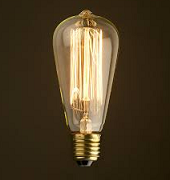 Can you measure the conductivity of water using a lux (light) meter? Well, in a round about way you can!For this month’s experiment we are going to investigate whether we can light a light bulb by creating a circuit in water simply by adding salt. Distilled water contains no salts and as a result does not conduct electricity. Salt molecules are made of Sodium ions and Chloride ions, when salt is added to water the sodium chloride dissociates in Na+ ions and Cl- ions and they are therefore free to travel through the water. These ions are then able to conduct electricity through the water medium. We will be establishing whether various concentrations of salt added to water will cause the bulb to light and whether higher concentrations produce a brighter light. Read on to find out what happened! | |||||||||||||||||||||||||||||
Equipment
Method 1) Aluminium foil was wrapped around the two pop sticks to ensure they were fully covered. These became our electrodes for the circuit. 2) The three pieces of wire had approximately 10mm of insulation stripped from each end and the wires were twisted. 3) One of the pieces of wire was connected to the negative terminal of the 9V battery; the other end was then connected to one of the electrodes and held in place using masking tape. 4) Another piece of wire was run from the positive terminal of the battery to the positive terminal of the globe holder. 5) The last piece of wire was connected from the globe holder to the other electrode. 6) The circuit was tested by touching the two electrodes together and ensuring the light bulb lit up. 7) The sensor of the LX-1108 was fitted to the foam box by cutting a whole in the side and was held in place using masking tape. The lid was then fitted to the foam box and an ambient level within the box recorded. 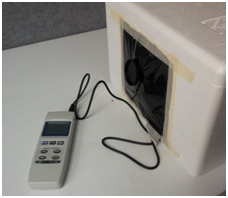 Figure 1: LX-1108 Fitted to Sealed Container 8) 400ml of distilled water was poured into the beaker and its conductivity was tested using the EC-PCTestr35, the result was then recorded for future reference. 9) The beaker, battery and light globe along with the electrodes were setup in the foam box and the circuit tested to see if the globe lit. The lid was then fitted to the foam box and a lux level was taken. 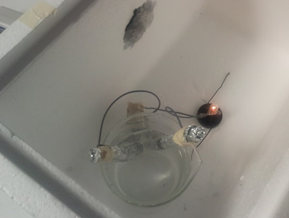 Figure 2: Beaker, battery, electrodes and globe setup for measurement 10) 0.2g of salt was weighed using the SCCL501 and was added to the water in the beaker and Step 9 was undertaken again. Salt was added progressively in 0.2g amounts and Step 9 was undertaken after each addition of salt until 1g of salt was reached. All results were recorded for later reference. Results
Table 1: This table shows the lux levels for the varying conductivity concentrations after the addition of salt. 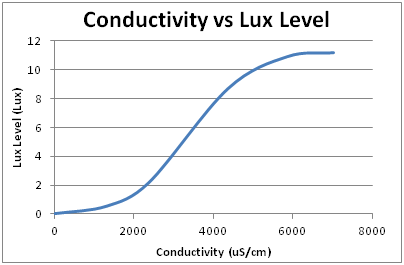 Figure 3: Shows the conductivity concentration with reference to the lux level produced Discussion and Conclusion The results show that when the conductivity of the water is above a certain value the light bulb lights. They also show that as the conductivity increases so does the lux level. This is due to there being more free ions within the water to transfer current to the bulb. It is interesting to note that as the conductivity increased above 6200µS/cm that the rise in lux level slowed. This is likely due to the amount of free ions in the water to transfer current being less readily available and as such the increase becomes slower. | |||||||||||||||||||||||||||||
Get your scientific instruments before the end of financial year.With the financial year coming to an end you might have left over funding that needs to be spent. At Instrument Choice we have a a variety of in stock items below which we can supply. We offer automatic 30 day accounts for all Australian Universities, Government, Council, Schools, and Hospitals. And remember our scientists are here to help, call 1300 737 871 to have a chat.  B-711 - Compact pH Meter - Single drop measurement.Compact pH Meter LAQUA twin 1 point calibration, accurate pH measurements in a few seconds, from a single drop.* Whether you need to keep the pH of an aquarium within tight limits, are checking for the acidity of rain water or for the quality of meat and fish products, LAQUAtwin compact pH meters are ideal for you. No matter where and when you need to test. | |||||||||||||||||||||||||||||
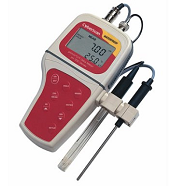 EC-PHWP300-02K Waterproof Cyberscan pH Meter with Double Junction Electrode.Waterproof CyberScan pH 300 pH/mV Meter with double junction pH electrode, ATC probe & pH carrying kit set. Expanded memory stores and recalls up to 50 readings with temperature. Automatic Temperature Compensation (ATC) for the highest accuracy under fluctuating temperatures. | |||||||||||||||||||||||||||||
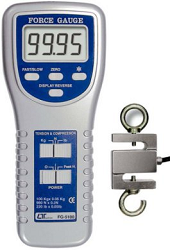 FG5100 - 100kG Force Gauge - Push & Pull.The FG5100 Force Gauge measures tension and compression up to 100 kg. The user can also select to obtain measurements in pounds or Newton. The backlit LCD display makes readings easy in lowlight environments. | |||||||||||||||||||||||||||||
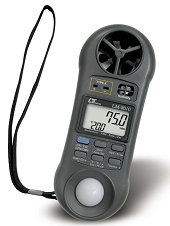 LM8010 - 5 in 1 Anemometer (plus more).5 in 1 professional measuring instrument: Anemometer, Air flow, Hygrometer, Thermometer, and Light meter. Tiny bone shape with lightweight and small size case design are suitable for handling with one hand. | |||||||||||||||||||||||||||||
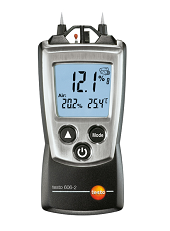 0560-6062 - Moisture Meter for Wood & Other Materials.In addition to material moisture, testo 606-2 also measures air moisture and temperature. In this way, drying conditions can be reliably assessed directly on-site. Precise measurement of wood moisture with stored characteristics curves for beech, spruce, larch, oak, pine, maple. Additional characterisitic curves for cement screed, concrete, plaster, anhydrite screed, cement mortar, lime mortar, brick. | |||||||||||||||||||||||||||||
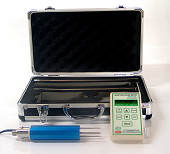 MPKit-ICT - Instant Soil Moisture Reading Kit.The MPKit-ICT has set the standard in soil moisture testing and is an ideal all round soil moisture water content device. Unlike other portable instruments, the sensor is not affected by temperature which other portable sensors are susceptible to. | |||||||||||||||||||||||||||||
